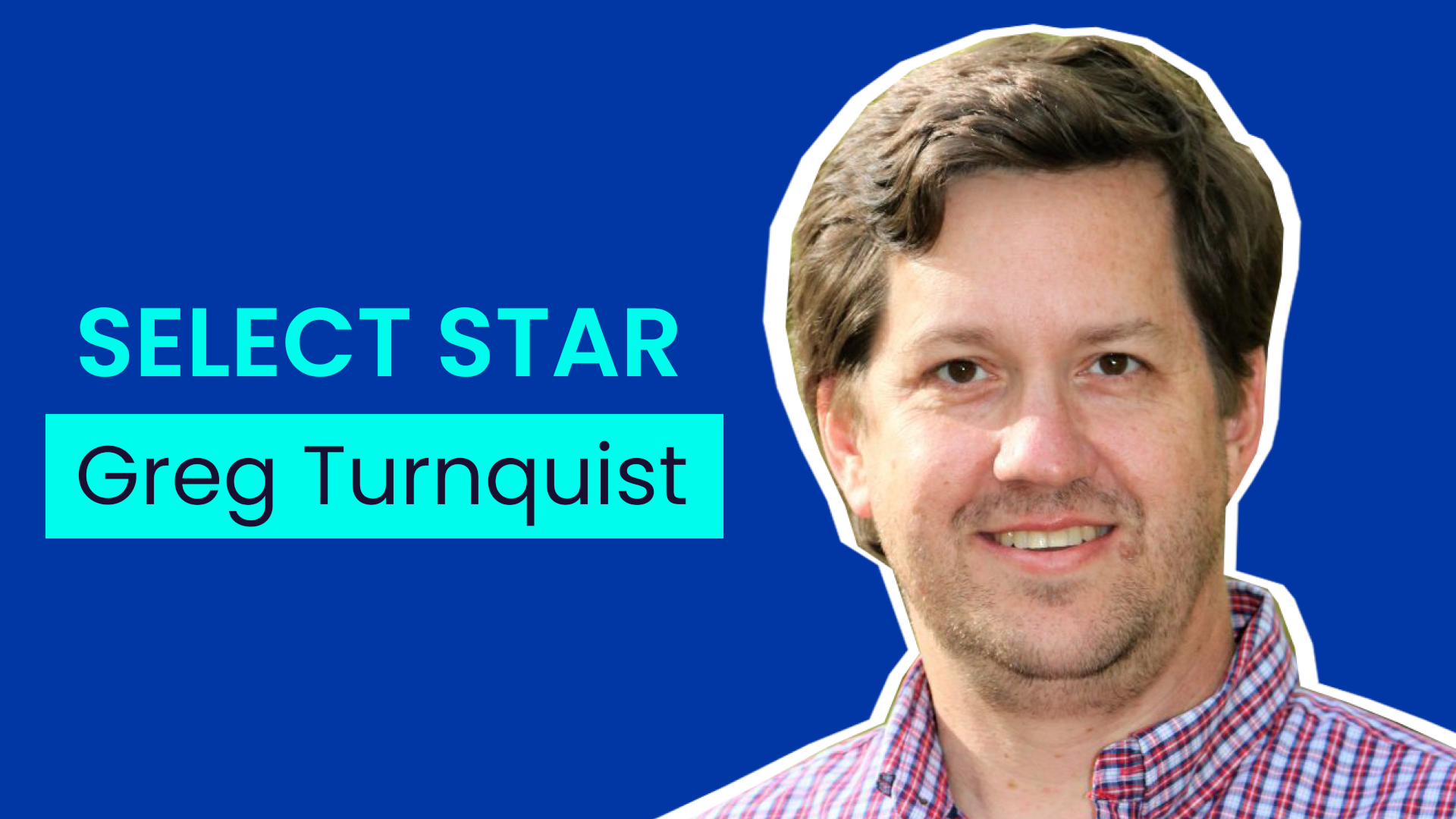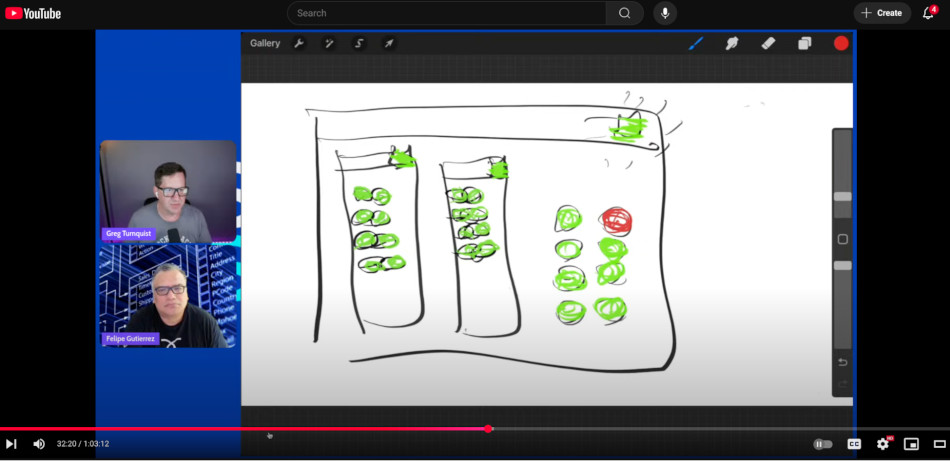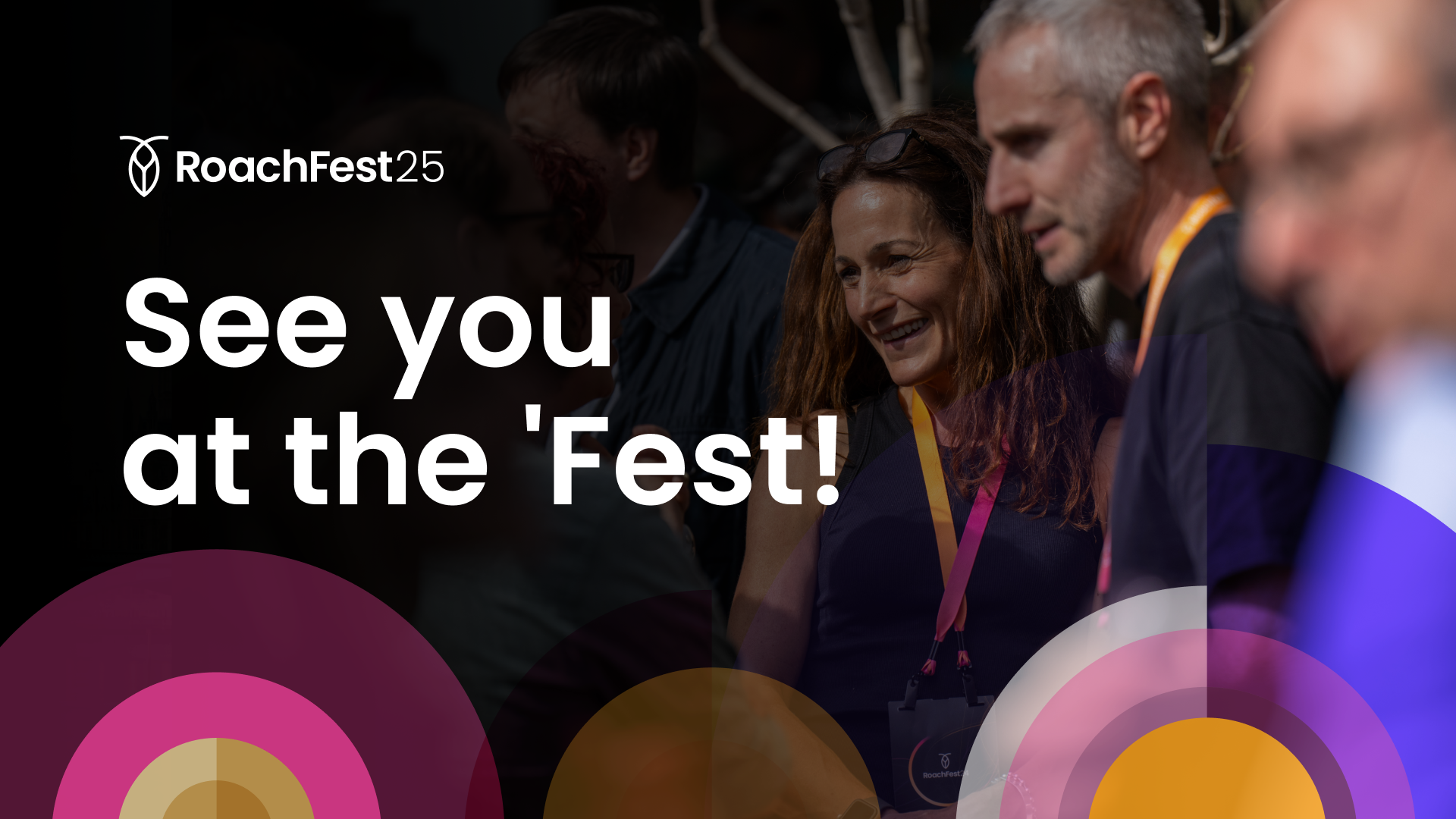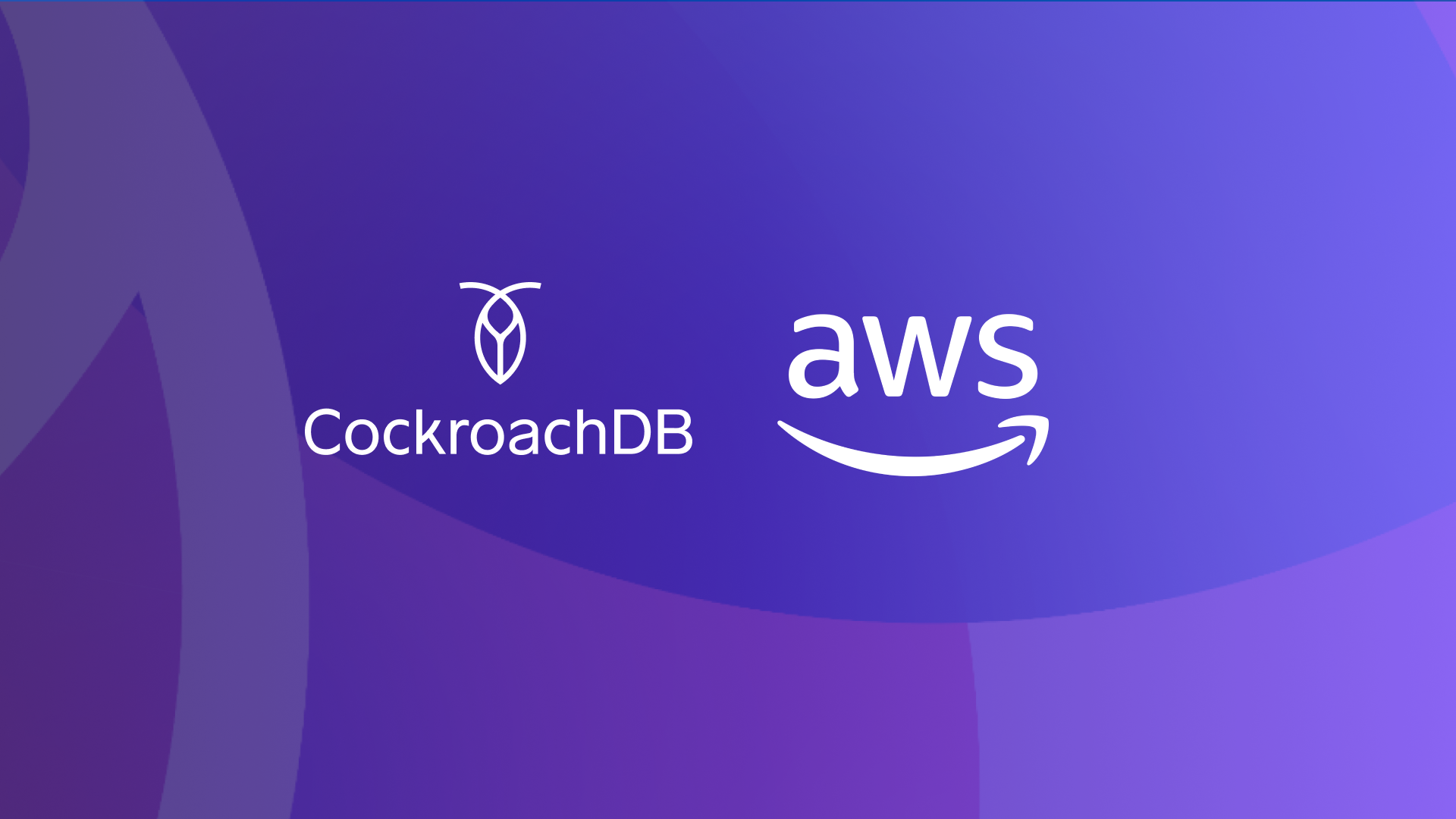Query detective? Training junky? Lead developer? All that and much more describes Greg Turnquist, who hosts the Cockroach Labs video and podcast series SELECT STAR.
In each SELECT STAR episode, Turnquist demystifies key data architecture concepts. He also loves to discuss distributed SQL, and provide valuable tips for CockroachDB. Developers get practical distributed database knowledge they can apply immediately, in a casual format that makes complex topics accessible.
As the former lead for Spring Data JPA and Spring Web Services, Turnquist brings his uniquely deep perspective to SELECT STAR. Guest experts are frequently featured, leading to spirited convos for developers, data architects, IT pros, and more.
Whether he’s creating new educational content for Cockroach University, producing CockroachDB training deep dives, or hosting SELECT STAR, you’ll always find him experimenting. As this Q&A reveals, getting creative with content is always Greg’s goal.
The data revolution is here
Would you say this is the most exciting time to be working in data?
"Amazingly, I would say yes… I've been in this industry for almost three decades, and there have been some tidal wave movements."
Greg began his career in 1997 when relational databases lived strictly on-premise, sized to match your server's capacity. "It was like building a bridge," he says. "This is the length, this is the weight – no negotiation."
Then web commerce changed everything. Greg recalls the pivotal moment when Sunday midnight deployments, chosen as the "low-traffic" window, no longer worked because global customers were always online.
"We can't operate where all the data lives in one place anymore," he states. "Mirrors aren't enough. We need people making commits, updates, and changes at all hours. That's a fundamentally different problem."
Despite those challenges – or perhaps because of them – Greg remains energized by his career trajectory. "Everybody wants to interact with data," he says. "When everybody wants it, it's a happening place."
Why distributed data drives innovation
What excites you about being part of the data ecosystem?
"It's something that's fascinated me… I didn't realize it until I interviewed at CockroachDB, but I've interacted with data my whole career."
He describes applications as "almost stateless" by themselves. Data gives applications context – the difference between a static program and something alive. "Stuff comes in,” he explains, “the wheels move, the flappers flip, and something comes out the other end."
Understanding and acting on data therefore transcends backend concerns, making databases a creative playground for devs. "If you can understand what data is doing, if you can get your arms around the data, there's a lot you can accomplish from a developer perspective," Greg says.
The distributed data challenge
What are the biggest challenges facing data architecture?
"It's not just big data – it's that it's spread all around."
Greg regularly hears from CockroachDB customers managing tables with billions of rows, joined to others with tens of millions. However, traditional replication models are breaking down. "People thought mirroring would solve it – just put a copy on the East Coast, Central Europe... but it's not enough," he observes.
What makes it harder: locality-aware expectations. "The guy on the East Coast cares about East Coast businesses, while the woman on the West Coast cares about West Coast services," says Greg. "You run into questions of: How do I make updates? How do I ensure ACID compliance across regions?"
Sometimes, even physics becomes a constraint. "We were helping a customer and looped in an enterprise architect," he recalls. "For the first time in a software engineering meeting, the speed of light was a critical component. I'd never seen that before."
From accidental pipeline to query detective
Where did your interest in data begin – how has it shaped your career?
"Back in the late '90s, when the dinosaurs were roaming the earth…"
Greg describes an early Romanian government contract where he suddenly realized he’d built a primitive data-processing pipeline: folders and scripts that passed files between systems. "It sounds like message-passing," he says now. "But we didn't have message brokers. To me, that was data processing."
Later, working on a project monitoring 22 sites (which quickly scaled to 800), Greg rediscovered SQL. "It was boring in college. It looked too simple." However, that changed when performance tanked.
"I had a DBA show me EXPLAIN PLAN," Greg explains. "He said, 'You did an upper clause — that broke the index.' And I was like, what's an index?" That moment launched a query quest. "I could see what the database was thinking," he says. "I rewrote queries from 50 seconds to subsecond, then moved on to the next one. That detective work became addictive."
His proudest achievement: fixing a save button that took 20 minutes to execute. After rewriting it, "It went subsecond," says Greg. "They didn't need coffee breaks anymore. They even gave me a little printed certificate for that. I didn’t care about the certificate – I cared that I had unblocked these people from doing their daily jobs."
Building Spring Data JPA for millions
(Note: Spring Data JPA is a Java framework – it simplifies database access by automatically generating queries and managing persistence, using the Java Persistence API (JPA).)
What were your responsibilities on Spring Data JPA, and what made it challenging or rewarding?
"Spring Data JPA was the third most popular module by download. 80% of new projects chose it for relational data."
Greg stepped in as sole maintainer when shared ownership wasn't working. His responsibilities included triaging issues, determining whether bugs belonged to Spring, Hibernate, or the JPA spec, and keeping the module moving forward.
"I had to admit I wasn't an expert in Hibernate, but my teammate in Germany was," says Greg. "He'd close out trivial issues in the morning before I even started, letting me focus on the tough ones."
One of Greg’s standout contributions: replacing a brittle regex hack for pagination. The result: pagination became production-ready for thousands of developers using the module daily. "They were parsing queries with regular expressions," Greg says. "That doesn't work. I had a background in compiler construction, so I built a real JPA parser using ANTLR."
The query optimization playbook
You wrote over 200 queries—did you follow a particular method? What lessons stuck with you?
"The biggest unlock was learning EXPLAIN PLAN. I was like, why did nobody tell me this before?"
Greg emphasizes understanding table relationships, cardinality, and the nuances between inner and outer joins. "You need to understand how tables link and what the optionality is," he says.
A memorable case involved modeling alarms from devices, cards, and ports in a multi-layered, one-to-many structure. "We had so many joins that eventually the DBA built a materialized view. However, we caught the database regenerating it — so for 200 milliseconds, it was empty. That was a mess."
The solution: they replaced it with a denormalized table. "It was a great example of real-world lessons that still inform how I think about CockroachDB," he says.
Teaching the distributed difference
What's your role at Cockroach Labs today?
"I'm part of the training team. Our job is to teach the delta – what's different about CockroachDB."
Greg helps build content that covers the differences between traditional RDBMSs and distributed systems. “Rules of thumb work until they don't – in distributed systems, many of those old rules don't,” he states.
The team creates slides, labs, videos, quizzes, and certifications for both developers and operators. They recently launched the CockroachDB Subscription Training Program to provide comprehensive, unlimited access to enterprises of all sizes.
"Trainers deliver the sessions, but we're the ones writing the content," he explains. "We're helping people build better apps by understanding how CockroachDB works under the hood."
SELECT STAR: Making learning stick
How did the SELECT STAR YouTube series come about, and how would you describe it?
"My little secret – maybe not a secret – is I started making YouTube videos in 2019."
Greg pitched the idea of a livestream developer show as a complement to Cockroach Labs' more architect-focused podcast content.
"We needed something entertaining and educational for developers actually using the product," he says. "I came up with the name while I was in the car, picking up my kids, and it hit me — SELECT STAR. It's what we tell people not to do in SQL. So it's a little inside joke, but catchy."
The show's vibe: a conversational space where developers learn practical concepts without feeling bored or overloaded. "If the architects, CTOs, and developers have a channel they can all learn from, that's a nice harmonious combination," he adds.
Check out this episode where Greg uses sketching to dig into the complex topic of 1-to-many relationships.
He also does live-coding sessions like this one, where he shows how to use Spring Data JPA to talk to your CockroachDB cluster. (Don’t worry! There is also content for Go developers and .NET geeks! SELECT STAR aims to serve the entire CockroachDB developer community.)
The education advantage
Why is teaching others such a big part of your career now?
"I didn't see it coming. Years ago, I helped teach martial arts as an assistant instructor, helping other students, and realized, 'I kind of enjoy this.'"
Over time, Greg discovered that teaching sharpened his own knowledge. "If someone's going to ask me a question, I want to have the right answer or go find it." That instinct carried over to his Spring conference talks, YouTube videos, and eventually, SELECT STAR.
He designs training materials to feel fresh with "pattern interrupts," a TV editing best practice. "The camera moves every 3 to 8 seconds to keep you engaged," says Greg. "Same with slides. If every slide is bullet points, you'll tune out. So I mix it up – diagrams, action headlines, different layouts."
"I find this kind of design work creatively stimulating," he continues. "After 10 years of being on call, it's nice to help people who already chose the software during regular working hours. Now they just want to learn how to use it. Those are my favorite kind of people."
The SELECT STAR experience
If someone tunes into SELECT STAR for the first time, what do you hope they take away?
"I want them to feel like, 'Hey, that was fun — that wasn't a snoozefest. I learned something, and I need to tune in again.'"
Whether it's a quick insight or deep dive, viewers should leave with something constructive. "I want to enrich their life," he says, "not waste their time."
Ready to dive deeper into distributed SQL? Experience the full SELECT STAR series and make new data discoveries with Greg Turnquist.
David Weiss is Senior Technical Content Marketer for Cockroach Labs. In addition to data, his deep content portfolio includes cloud, SaaS, cybersecurity, and crypto/blockchain.







